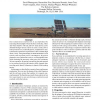Free Online Productivity Tools
i2Speak
i2Symbol
i2OCR
iTex2Img
iWeb2Print
iWeb2Shot
i2Type
iPdf2Split
iPdf2Merge
i2Bopomofo
i2Arabic
i2Style
i2Image
i2PDF
iLatex2Rtf
Sci2ools
72
Voted
ICRA
2002
IEEE
2002
IEEE
First Experiment in Sun-Synchronous Exploration
Sun-synchronous exploration is accomplished by reasoning about sunlight: where the Sun is in the sky, where and when shadows will fall, and how much power can be obtained through various courses of action. In July 2001 a solar-powered rover, named Hyperion, completed two sunsynchronous exploration experiments in the Canadian high arctic (75°N). Using knowledge of orbital mechanics, local terrain, and expected power consumption, Hyperion planned a sun-synchronous route to visit designated sites while obtaining the necessary solar power for continuous 24-hour operation. Hyperion executed its plan and returned to its starting location with batteries fully charged after traveling more than 6 kilometers in barren, Mars-analog terrain. In this paper we describe the concept of sun-synchronous exploration. We overview the design of the robot Hyperion and the software system that enables it to operate sunsynchronously. We then discuss results from analysis of our first experiment in sun-sync...
Related Content
| Added | 15 Jul 2010 |
| Updated | 15 Jul 2010 |
| Type | Conference |
| Year | 2002 |
| Where | ICRA |
| Authors | David Wettergreen, M. Bernardine Dias, Benjamin Shamah, James Teza, Paul Tompkins, Chris Urmson, Michael D. Wagner, William Whittaker |
Comments (0)

